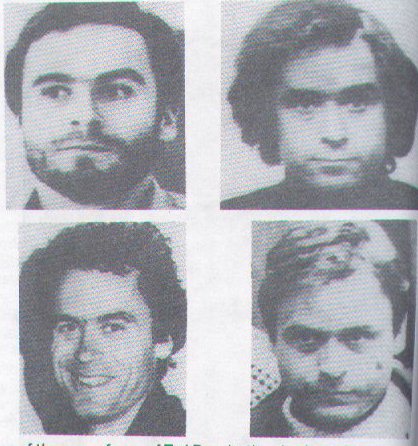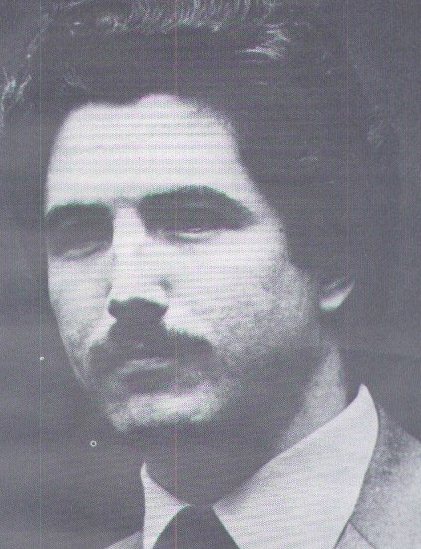
|
|
Serial Killers 2
David Berkowitz - Son of Sam
David Berkowitz was born in 1953. Rejected and adopted as a child, he concealed his low self-esteem by compulsive lying and bragging. And his extreme shyness toward women by assailing them, starting when he was in his early twenties. His courage bolstered by several non-fatal stabbing attacks. Berkowitz bought a gun in 1976 and began a series of impulse killings that paralyzed New York City. Approaching male and female victims randomly selected as they sat on stoops or in cars. He shot them at point-blank range. This reign of terror lasted 13 months, resulting in six deaths and seven serious injuries Police had no witnesses. no suspect. and no motive until the discovery of a letter at a crime scene. It read in part, " I am a monster. I am the Son of Sam love to hunt" and claimed that his father. "Sam", ordered him to kill, after abusing him violently. A second "Son of Sam" note was received by newspaper columnist Jimmy Breslin. Luck led police to the killer. After a double murder in July 1977 a witness spotted a man jumping into a nearby car that had just received a parking ticket. Police located the car and noticed a gun and a letter on the front seat, written in "Son of Sam`s" handwriting. They arrested Berkowitz, a quiet, smiling man, who lived alone in a filthy apartment covered in trash and mad graftti. Berkowitz told police he had taken his alias not from his adopive father whom he hated, but from the owner or a Labrador dog whose barking kept him awake nights. Pleading insanity, he said he heard voices and that the dog had told him to kill. Judged sane he was convicted of murder and sentenced to 365 years in prison..
|
| |
Marie BeckerIn many respects, Marie Becker's discontent was no different from that of many of her peers not only in her native Liege, but the civilised world over. The years had passed over her in a drab succession, offering an excess neither of joy nor excitement, and the grey vista of mediocrity stretched as far ahead as she dared to look. After fifty-three years, twenty of them spent chained by wedlock to an honest but unromantic and unimaginative cabinet-maker, Madame Becker was desperate for a change. In a word, Marie was looking for thefrisson of romance; which happened to be what Monsieur Lambert Bayer was also seeking. The passionate affair that followed wrought a change in Marie Becker as dangerous as it was unexpected.
The first casualty, in the autumn of 1932, was Charles Becker who, though previously of stout constitution, could not have been expected to withstand the massive dose of digitalis that his wife administered. Becker was followed into his grave by Bayer in November l934, and for the time being at least the widow Becker had a little money and a lot of freedom. It seemed almost as though she had recaptured some of the lost years of youth she began to dress in gaudy clothes and extravagant make-up, and friends and neighbours were more than a little scandalised by this elderly lady's late-night revelling, and the endless string of lovers half her age, for whose 'services' Marie Becker was obliged to pay. And herein lay the problem - Madame Becker still had the freedom, but was rapidly running out of money with which to buy what passed for romance.
Then in July 1935 a friend, Marie Castadot, was seized with attacks of nausea; she was nursed by Madame Becker, but on the 23rd she died. And so in fairly rapid succession did a number of others among the merry widow's circle of friends and acquaintances. It was not until October 1936, when the police began to receive anonymous letters accusing Marie Becker of poisoning two elderly widows named Lange and Weiss, that investigations uncovered a whole series of similar cases - Julia Bossy, Jeanne Perot, Aline-Louise Damorette, Anne Stevart, Mathilde Bulte and more. All had been nursed in their final days by Madame Becker. A search of her apartment yielded a storehouse of women's clothing and jewellery.
Marie Becker was taken into custody and when searched a small green flask was found in her handbag, its contents later identified by a chemist as digitalis. The drug was customarily administered in small doses to patients suffering from heart complaints, though in large doses it is a poison as deadly as any. It was to be Madame Becker's consistent claim that she carried the digitalis because she had heart trouble. The problem for her was that all the dead women that she had nursed, when exhumed, also contained fatal residues of the drug.
At her trial, which at times bordered on pantomime, Marie Becker indignantly denied the eleven charges of murder brought against her, though she nevertheless seems greatly to have amused the court with descriptions of her 'patients' as they approached the day of their celestial judgement. One, she thought, 'looked like an angel choked with sauerkraut'. Madame Becker was, predictably, found guilty of murder and routinely sentenced to death. However, in accordance with the established practice in Belgium*, the sentence was commuted to life imprisonment. Marie Becker died some years later in prison.
* Belgium has only once in 1918 used the death penalty for civilian crimes since 1863
|
 David Berkowitz
David Berkowitz |
| |
Ted BundyBundy was a law student, who was very charming. He was our next door neighbor, the boy next door; the last one we would ever want to suspect (which is often said by many people who have known the serial killers).
His crimes were chilling and brutal (as they usually are). The crimes began in Washington; his first victim was beaten with a metal rod in 1974 while she was asleep. She did survive the attack though. It was
only four weeks later that Bundy would claim the next victim, Lynda Ann Healy, who vanished from her coed basement room in a group house.
Her sheets were bloodstained.
He traveled from Washington to Utah to Colorado and Florida leaving a trail of missing, brutally beaten, raped young women behind him. While in Utah, he was arrested. In his car, a ski mask, ice pick, and crowbar were found. He was then identified by Carol DaRonch as the man who tried to kidnap her. Bundy was convicted and sent to Colorado to stand trial. He escaped twice during the pre-trial hearings and was "on the lam" for nearly 2 months.
He was finally recaptured in Florida where one of his final victims was a junior high school student named Kimberly Leach, which was pretty young for him. The others were Lisa Levy and Margaret Bowman. It was,in fact, the bite marks on Margaret Bowman's buttocks which, for the most part, sealed his fate.
He was convicted and sentenced to death. However, he was allowed to marry while on death row. Unknown at the time to the prison officials,Bundy's new wife got pregnant.
To conclude, Bundy once asked a friend/associate of his which states had the death penalty. It is believed the Bundy thought he was smart enough to get out of the death penalty.
On January 24th, 1989, Ted Bundy found out how wrong he was when he was executed in the electric chair in Florida
|
 The Many Faces of Ted Bundy
The Many Faces of Ted Bundy |
| |
Kennneth Bianchi & Angelo BuonoKenneth Bianchi and Angelo Buono strangled twelve women in Los Angeles between October 1977 and February 1978. They would usually pick up women by posing as police detectives or soliciting clients. They would then tie the woman up and rape and sodomize her and then strangle her, dumping the bodies in the familiar places of L.A.
The newspapers called them the Hillside Strangler as the police did not release the information that they knew them to be two killers. Bianchi and Buono owned a prostitute service with several employees.
The murders started when a prostitute had sold a bogus list to Buono with the names of probable clients. When Buono discovered it to be fake, he took his revenge out on the prostitutes friend, Yolanda Washington by raping and killing her. He carried out the crime with his cousin Kenneth Bianchi, it was obvious that they were so obsessed with rape and murder that they became serial killers. When the two were together it was an explosive combination of personalities that drove them to kill.
On January 1979, after 12 murders, Bianchi had moved to Bellingham, in Washington State. He had followed his girlfriend who had moved there with his newborn son, on reccomendation of Buono. Bianchi had supported his son by taking up a job as a local security guard. Soon the obsession to rape and murder was so strong that he killed two women whom he had offered a house sitting job. It was these murders that led to the suspicion of Bianchi because he had been metioned in the victims conversation the previous day and on further investigation fibres on the victims matched ones found on Bianchi's clothes. When the police searched Bianchi's house they discovered jewellery that belonged to the Hillside Stranglers victim's.
Police from L.A. travelled to Bellingham and interviewed Bianchi. From the evidence and the similarities of the murders, they knew that Bianchi was one of the Hillside Stranglers. On further questioning Bianchi revealed the name of Buono.
Bianchi, who was already facing charges on the powerful evidence, gave police the story of how his crimes were committed by his multiple personality - Steve. But when under hypnosis and displaying unusual actions for a multiple, a doctor said he was faking it to prevent the death penalty.
Bianchi who was even more desperate to avoid the death sentence, agreed to testify against Buono. The police had alot of evidence to convict Bianchi, and a testimony by Bianchi was certain to convict Buono.
On 21 October 1983, Bianchi escaped the death penalty and was sentenced to life imprisonment. Buono did not receive a death sentence, and was also sentenced to life imprisonment without the possibility of parole.
|

Kenneth Bianchi |
|